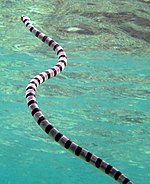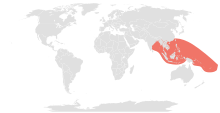Adder flattail
| Adder flattail | ||||||||||||
|---|---|---|---|---|---|---|---|---|---|---|---|---|

Adder flattail ( Laticauda colubrina ) |
||||||||||||
| Systematics | ||||||||||||
|
||||||||||||
| Scientific name | ||||||||||||
| Laticauda colubrina | ||||||||||||
| ( Schneider , 1799) |
The adder flattail or the yellow-lipped sea snake ( Laticauda colubrina ) belongs within the family of poisonous snakes (Elapidae) to the genus of flattails ( Laticauda ). The species was first scientifically described in 1799 by the German natural scientist Johann Gottlob Schneider .
features
The adder flattail has a cylindrical, slender body, the head is oval and hardly separates from the body. The animal reaches a body length between 110 and 140 cm and is markedly drawn. The basic color is between yellowish, whitish blue and dark blue, while black transverse bands run relatively regularly over the entire body. The top of the head is black, the top and tip of the snout is yellowish or corresponds to the basic color. A black band can be seen between the eye and the corner of the mouth, and the underside of the mouth is also spotted black and striped on the edge. The black drawing of the head can merge into the first horizontal stripe in the neck or be connected to it. The tip of the tail is flattened vertically like a fin.
Way of life

|

|
|
|
In comparison: the flattail viper (left) and its prey, the ring snake eel ( Myrichthys colubrinus , right).
|
||
The adder flattail is nocturnal and during the day often hangs out of the water in dry crevices and caves between the rocks of the coast. The species has also been observed climbing in small bushes. Laticauda colubrina often penetrates quite deep into the inland of islands, in the Solomon Islands it has established itself in this way in the brackish water lake Lake Te′Nggano. This makes it the most land-based sea snake. The flattail adder probably also comes ashore to take up fresh water. As a food specialist, it feeds on eel-like fish . Prey also includes those who attempt to mimic flattails through mimicry . In the Fiji Islands , it has been shown that females eat larger prey than males, regardless of the size of the snake. From the onset of dusk, the animals start looking for food: prey animals are tracked down with their sense of smell and paralyzed with a poison bite. Adder flattails are oviparous (egg-laying) snakes. The females deposit a clutch of 6 to 20 eggs on the beach, sometimes in large groups.
Snake venom
The adder flattail has comparatively small, fixed poison teeth in the front upper jaw, through which a highly effective poison is released when a bite occurs. It is mainly composed of neurotoxins . In addition, it shows myotoxic properties and the associated kidney-damaging effects due to dead muscle cells.
Bites can go unnoticed as there are hardly any local reactions. Life-threatening consequences can be circulatory failure or respiratory paralysis. Bite accidents have been proven, but extremely rare due to the nocturnal lifestyle and very low level of aggressiveness.
Occurrence
The adder flattail is common in the East Indies and the western Pacific Ocean . It can be found from Sri Lanka via Southeast Asia to Japan and penetrates as far as the Fiji islands. The species is found near the coast and mostly in coral reefs , mangrove forests and between rocks.
Protection status
The adder flattail - including its skin - is protected in Appendix D of the EU species protection regulation.
literature
- Dieter Schmidt: Atlas snakes. Nikol-Verlag, ISBN 978-3-86820-011-9 .
- Mark O'Shea: Venomous snakes. All species in the world in their habitats. Franckh-Kosmos Verlag, Stuttgart 2006, ISBN 3-440-10619-5 .
- Chris Mattison: Encyclopedia of Snakes. blv Verlag, ISBN 978-3835403604 .
Web links
- Laticauda colubrina in The Reptile Database
- Laticauda colubrina inthe IUCN 2013 Red List of Threatened Species . Posted by: Lane, A., Guinea, M., Gatus, J. & Lobo, A., 2009. Retrieved January 7, 2014.
Individual evidence
- ↑ a b Mark O'Shea et al: Herpetological Diversity of Timor-Leste Updates and a Review of species distributions. In: Asian Herpetological Research. 2015, 6 (2): pp. 73-131., Accessed on July 17, 2015.

